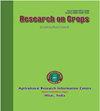Interdependence of effects between soil organic matter content and atrazine herbicide on weeds and sweet corn (Zea mays saccharata Sturt) yields
Q3 Agricultural and Biological Sciences
引用次数: 0
Abstract
One of the efforts to increase sweet corn productivity is to suppress weed growth by using herbicides combined with organic matter. This study aimed at examining the effectiveness of the herbicide atrazine on weed growth, growth and yield of corn plants given different doses of organic C. The experimental design used was divided plot design with three main plots of organic fertilizer levels and six subplots of herbicides which were replicated thrice. The main plot factor was the C-organic content consisting of low (1.02%), medium (2.50%) and high (3.50%). The second factor was the dose of the herbicide atrazine, which consisted of six levels of treatment, namely, no herbicide, atrazine herbicide doses of 1, 1,4, 1,8, 2.2 and 2.6 kg/ha. The results showed that the combination of atrazine at a dose of 1.4-2.6 kg/ha with organic C content was effective in controlling Ageratum conyzoides, Panicum repens and Paspalum conjugatum weeds. Atrazine herbicide treatment at a dose of 2.2 kg/ha affected the length of the cob, the weight of the cob without the cob, the yield of plots and the yield per hectare.土壤有机质含量与阿特拉津除草剂对杂草和甜玉米产量影响的相关性
提高甜玉米产量的努力之一是通过使用除草剂和有机物来抑制杂草生长。本研究旨在检验除草剂阿特拉津在不同有机C剂量下对玉米植株杂草生长、生长和产量的影响。实验设计采用三个有机肥水平的主地块和六个重复三次的除草剂子地块的分地块设计。主要小区因子是C有机物含量,包括低(1.02%)、中(2.50%)和高(3.50%)。第二个因子是除草剂阿特拉津的剂量,它包括六个水平的处理,即无除草剂,阿特拉津除草剂的剂量为1、1、4、1、8、2.2和2.6公斤/公顷。结果表明,1.4-2.6kg/ha的阿特拉津与有机碳含量的组合对三角叶、白穗草和结合Paspalum杂草有较好的防治效果。2.2公斤/公顷的阿特拉津除草剂处理影响了玉米芯的长度、没有玉米芯的玉米芯的重量、地块产量和每公顷产量。
本文章由计算机程序翻译,如有差异,请以英文原文为准。
求助全文
约1分钟内获得全文
求助全文
来源期刊

Research on Crops
Agricultural and Biological Sciences-Soil Science
CiteScore
1.50
自引率
0.00%
发文量
93
审稿时长
1 months
期刊介绍:
The Research on Crops is a peer-reviewed journal publishing original research papers, review articles and short communications in English on all basic and applied aspects of crop sciences, agricultural water management, agro-climatology, agroforestry, agronomy, crop production, crop protection, cropping systems, food science & technology, genetics & plant breeding, horticulture, plant & soil science, plant biotechnology, plant nutrition, post-harvest management of crops, seed science, soil management & tillage, vegetables, weed science, agricultural engineering, agri-business, agricultural economics and extension, etc. The aim of the journal is to provide a forum for the scientific community to publish their latest research findings.
The manuscripts submitted for publication should not contain data older than 4 years on the date of submission.
The articles submitted for publication in this journal should not be submitted elsewhere simultaneously for publication in another journal. These should not carry any copyright material without prior permission of copyright holder.
The articles should present a complete picture of the investigation made and should not be split into parts.
There is no prescribed limit regarding the number of pages in case of full-length articles. However, the authors are advised to keep the length of their articles from 4 to 10 full printed pages of the journal.
The articles should be divided into the sub-sections: ABSTRACT, INTRODUCTION, MATERIALS AND METHODS, RESULTS AND DISCUSSION, CONCLUSIONS, and REFERENCES. Tables and figures should be appended separately at the end.
 求助内容:
求助内容: 应助结果提醒方式:
应助结果提醒方式:


